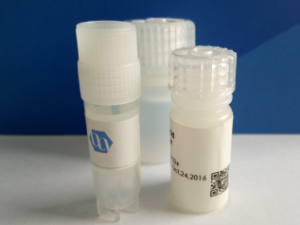$ 950.0
Quantity: 50 MG
In stock (can be backordered)
Description
Product name: Ranalexin
Catalog#: 1399050
Organism: bullfrog, Rana catesbeiana
Synonyms:
CAS NO.:
Sequence: Phe-Leu-Gly-Gly-Leu-Ile-Lys-Ile-Val-Pro-Ala-Met-Ile-Cys-Ala-Val-Thr-Lys-Lys-Cys
Modifications: disulfide,
M.W:
M.F.:
Purity: 95% by HPLC
Counter ion: Trifluoacetate
Format: Lyophilized powder
Description: Ranalexin, a 20-residue peptide isolated from the skin of the bullfrog Rana catesbeiana displays antimicrobial activity. This peptide contains two cysteine residues in positions 14 and 20 linked by a disulphide bridge. Ranalexin showed antibacterial activities against Staphylococcus aureus, Streptococcus pyogenes, E. coli, and multidrug-resistant strains of S. aureus with minimum inhibitory concentration values between 8 and 128 μg/ml. Ranalexin is also cytotoxic in HeLa and COS7 human cancer cells (IC50 = 13-15 μg/ml). Combination of lysostaphin with ranalexin resulted in potent, synergistic inhibition of S. aureus MSSA476 and MRSA252. Synergistic inhibition was specific for lysostaphin-susceptible staphylococci and was not observed with clinical isolates of the Gram-negative Escherichia coli, or other Gram-positive organisms, such as Enterococcus faecalis. Lysostaphin was not specifically synergistic with ranalexin alone. Synergy was also observed with two other cationic antimicrobial peptides, magainin 2 and dermaseptin s3(1-16); although combination with ranalexin was most potent. Synergistic inhibition by ranalexin in combination with lysostaphin resulted in an enhanced bactericidal effect. Importantly, synergy between lysostaphin and ranalexin was also observed after impregnation and drying in filter paper discs that clearly inhibited growth of S. aureus on the surface of agar; a solid, porous matrix. Thus, the combination could represent a novel route to target wounds infected with drug-resistant MRSA via dressings impregnated with the two compounds.
Uniprot ID: P39084
Usage: For Scientific Research Use Only, Not for Human Use.

